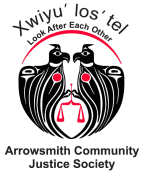
Arrowsmith Community Justice Society
XWIYU ’LOS’ TEL (Look After Each Other)
At ACJS, we are honoured to contribute meaningfully to our Oceanside community. Our trained facilitators work with all individuals affected by a particular crime or conflict, to engage in a carefully planned and coordinated process designed to allow all voices to be heard, resulting in a resolution to repair the harm done to individuals or their community. In this way, we help to strengthen our community by “looking after each other”.

Arrowsmith Community Justice Society
XWIYU ’LOS’ TEL (Look After Each Other)
At ACJS, we are honoured to contribute meaningfully to our Oceanside community. Our trained facilitators work with all individuals affected by a particular crime or conflict, to engage in a carefully planned and coordinated process designed to allow all voices to be heard, resulting in a resolution to repair the harm done to individuals or their community. In this way, we help to strengthen our community by “looking after each other”.
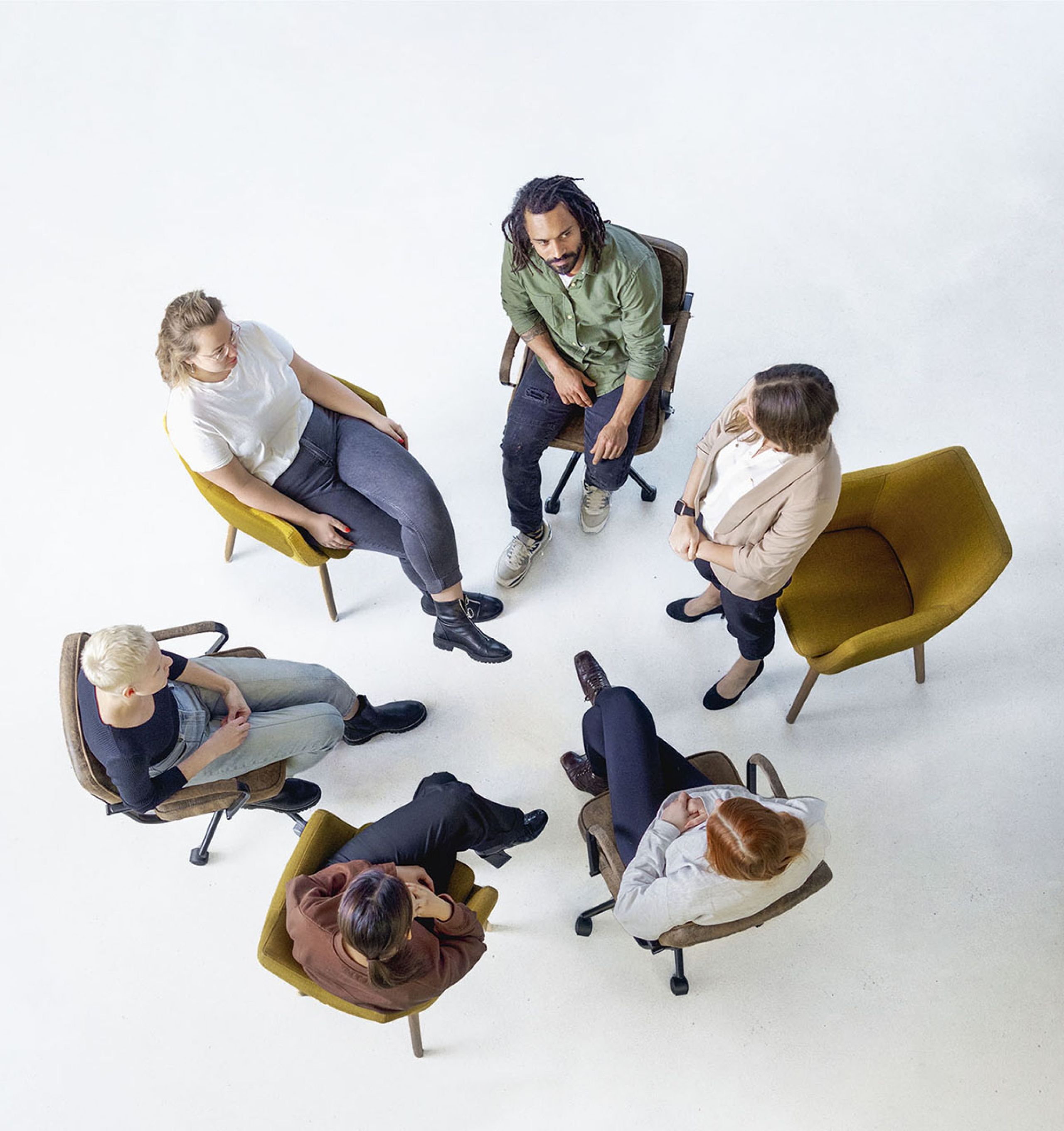

XWIYU ’LOS’ TEL (Look After Each Other)
At ACJS, we are honoured to contribute meaningfully to our Oceanside community. Our trained facilitators work with all individuals affected by a particular crime or conflict, to engage in a carefully planned and coordinated process designed to allow all voices to be heard, resulting in a resolution to repair the harm done to individuals or their community. In this way, we help to strengthen our community by “looking after each other”.

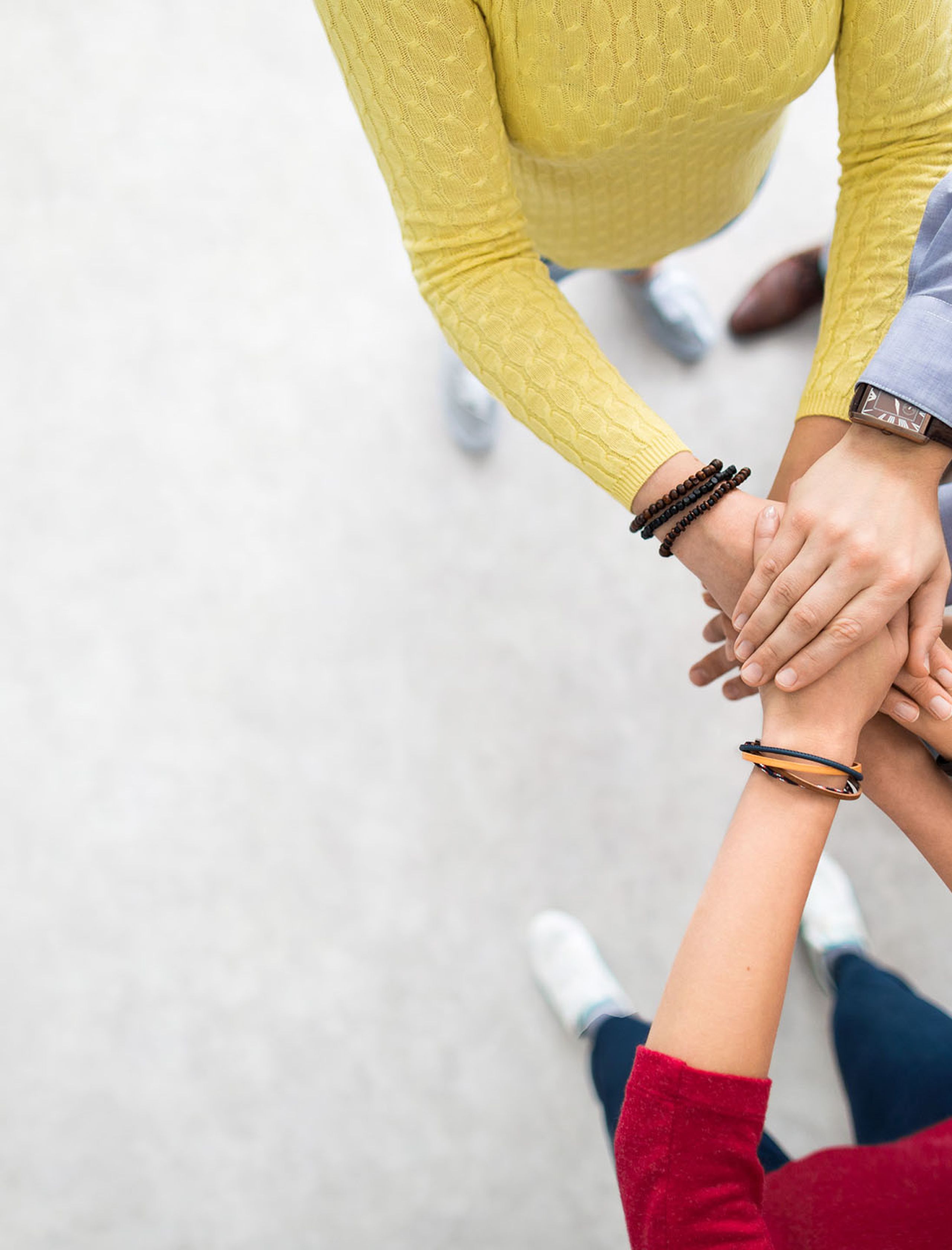
XWIYU ’LOS’ TEL (Look After Each Other)
At ACJS, we are honoured to contribute meaningfully to our Oceanside community. Our trained facilitators work with all individuals affected by a particular crime or conflict, to engage in a carefully planned and coordinated process designed to allow all voices to be heard, resulting in a resolution to repair the harm done to individuals or their community. In this way, we help to strengthen our community by “looking after each other”.
The Meaning Behind
Our Logo
XWIYU ’LOS’ TEL (whee-a-LOS-tel) hul’q’umi’num
Our logo was a gift from Kwalicum First Nations Elder and artist, Gordon Reid Senior. The two thunderbirds represent individuals meeting face to face and heart to heart to find a way to resolve the harm that has been caused. The scales of justice represent the balanced process restorative justice provides for all involved. The logo is in the shape of a circle which tells of each person’s equality within the process, with the top of the circle completed by a red arc representing “a brighter future” we can experience after the restorative process is completed. Every morning Gordon and his siblings left for school, his mother said “Xwiyu ‘Los’ Tel” which means “look after each other”.

The Meaning Behind
Our Logo
Our Logo
XWIYU ’LOS’ TEL (whee-a-LOS-tel) hul’q’umi’num
Our logo was a gift from Kwalicum First Nations Elder and artist, Gordon Reid Senior. The two thunderbirds represent individuals meeting face to face and heart to heart to find a way to resolve the harm that has been caused. The scales of justice represent the balanced process restorative justice provides for all involved. The logo is in the shape of a circle which tells of each person’s equality within the process, with the top of the circle completed by a red arc representing “a brighter future” we can experience after the restorative process is completed. Every morning Gordon and his siblings left for school, his mother said “Xwiyu ‘Los’ Tel” which means “look after each other”.
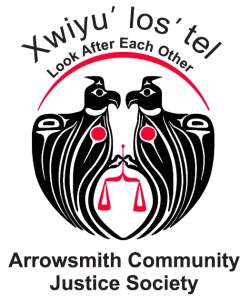
Our Story
Since 1999, Arrowsmith Community Justice Society (ACJS) has evolved and grown.
The Program Coordinator and community volunteers work in various areas of the program as facilitators, board members, de-briefing teams, trainers, policy writers, and public relations speakers. Contributors actively seek ways to expand the program and to share the philosophy of restorative justice with our community.
Spring 1997
Oceanside RCMP hosts a community symposium to discuss community needs. The concept of restorative justice (RJ) is introduced as a value.

Phase 1 1997
ACJS members inform and educate the community about RJ philosophy, and determine the model to be developed.
Six volunteers meet with various community groups, and with the help of local media, a knowledge base is put forward.
A group of 150 community delegates meet and choose the Community Conference model; local governments approve proceeding to Phase 2.

Phase 2 1997
Steering Committee members develop and implement the program. They are:
- Alan Bishop, Director, Parks & Recreation
- Frank Collins, retired businessman, Qualicum Beach
- Joyce Daman, retired educator, Qualicum Beach
- Gordon Reid, Qualicum First Nations
- Sam Stevens, Criminal Defence Lawyer
- Tom Watson, Assistant Superintendent SD69
- Caryl Wylie, retired bank, Nanoose Bay
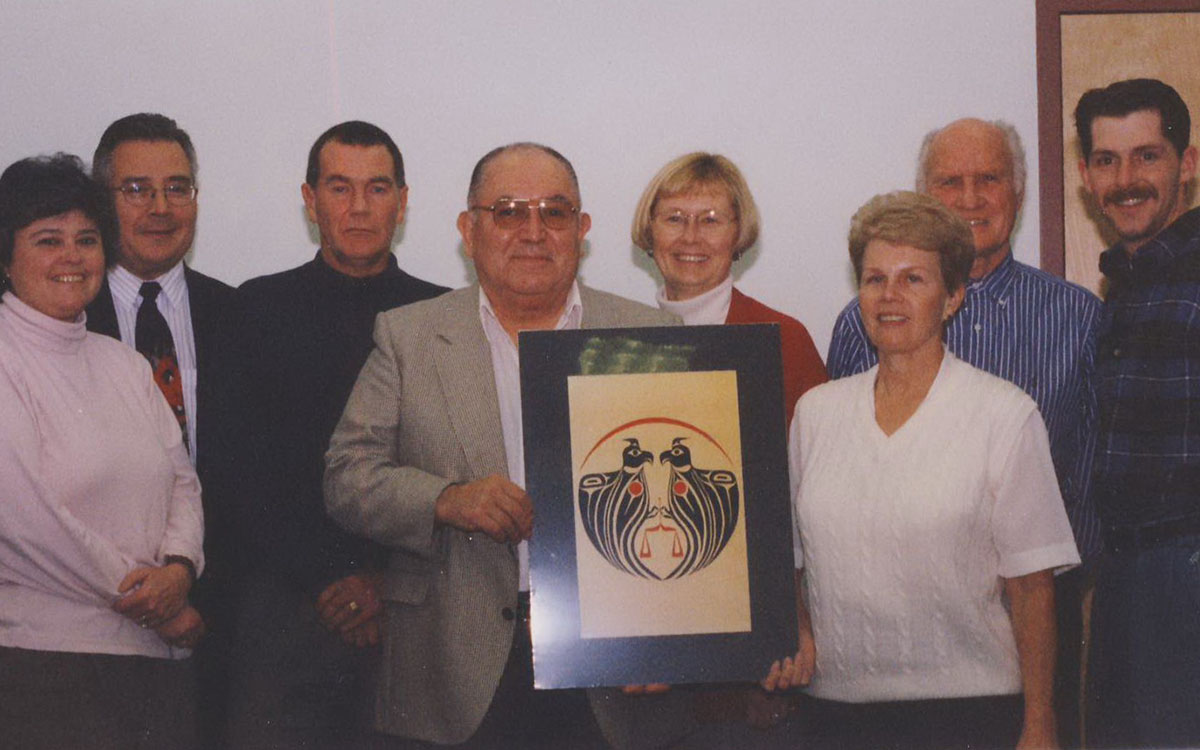
January 1999
ACJS becomes a charitable society and training of volunteers begins. The first training includes 30 individuals: 6 Victim Service workers and 45 RCMP members.
Trainers from existing RJ programs and the Justice Institute guide attendees through the conference process and prepare them for their individual duties in the program.
It is determined that an in-house program will be developed.

March 1999
- First referral made to ACJS.
- For the next 10 years referrals are made only by the RCMP.
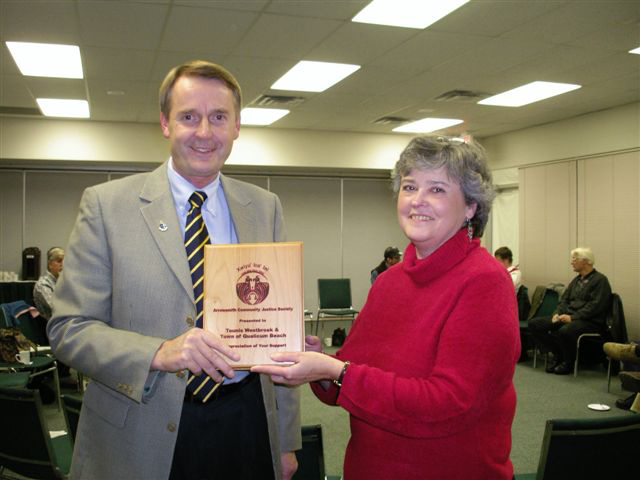
2009
ACJS expands to include a Community Dispute Resolution Program that permits referrals from members of the general public experiencing conflict.
2019
ACJS partners with the school district to provide a restorative approach to youth experiencing conflict in the school environment.
2022
ACJS signs a Memorandum of Understanding with Crown Council, allowing referrals to come directly from the Crown.
Our Story
Since 1999, Arrowsmith Community Justice Society (ACJS) has evolved and grown.
The Program Coordinator and community volunteers work in various areas of the program as facilitators, board members, de-briefing teams, trainers, policy writers, and public relations speakers. Contributors actively seek ways to expand the program and to share the philosophy of restorative justice.
Spring 1997
Oceanside RCMP hosts a community symposium to discuss community needs. The concept of restorative justice (RJ) is introduced as a value.
Phase 1 1997
ACJS members inform and educate the community about RJ philosophy, and determine the model to be developed.
Six volunteers meet with various community groups, and with the help of local media, a knowledge base is put forward.
A group of 150 community delegates meet and choose the Community Conference model; local governments approve proceeding to Phase 2.
Phase 2 1997
Steering Committee members develop and implement the program. They are:
- Alan Bishop, Director, Parks & Recreation
- Frank Collins, retired businessman, Qualicum Beach
- Joyce Daman, retired educator, Qualicum Beach
- Gordon Reid, Qualicum First Nations
- Sam Stevens, Criminal Defence Lawyer
- Tom Watson, Assistant Superintendent SD69
- Carl Wylie, retired bank, Nanoose Bay
January 1999
ACJS becomes a charitable society and training of volunteers begins. The first training includes 30 individuals: 6 Victim Service workers and 45 RCMP members.
Trainers from existing RJ programs and the Justice Institute guide attendees through the conference process and prepare them for their individual duties in the program.
It is determined that an in-house program will be developed.
March 1999
- First referral made to ACJS.
- For the next 10 years referrals are made only by the RCMP.
2009
ACJS expands to include a Community Dispute Resolution Program that permits referrals from members of the general public experiencing conflict.
2019
ACJS partners with the school district to provide a restorative approach to youth experiencing conflict in the school environment.
2022
ACJS signs a Memorandum of Understanding with Crown Council, allowing referrals to come directly from the Crown.
Spring 1997
Oceanside RCMP hosts a community symposium to discuss community needs. The concept of restorative justice (RJ) is introduced as a value.
Phase 1 1997
ACJS members inform and educate the community about RJ philosophy, and determine the model to be developed.
Six volunteers meet with various community groups, and with the help of local media, a knowledge base is put forward.
A group of 150 community delegates meet and choose the Community Conference model; local governments approve proceeding to Phase 2.
Phase 2 1997
Steering Committee members develop and implement the program. They are:
- Alan Bishop, Director, Parks & Recreation
- Frank Collins, retired businessman, Qualicum Beach
- Joyce Daman, retired educator, Qualicum Beach
- Gordon Reid, Qualicum First Nations
- Sam Stevens, Criminal Defence Lawyer
- Tom Watson, Assistant Superintendent SD69
- Carl Wylie, retired bank, Nanoose Bay
January 1999
ACJS becomes a charitable society and training of volunteers begins. The first training includes 30 individuals: 6 Victim Service workers and 45 RCMP members.
Trainers from existing RJ programs and the Justice Institute guide attendees through the conference process and prepare them for their individual duties in the program.
It is determined that an in-house program will be developed.
March 1999
- First referral made to ACJS.
- For the next 10 years referrals are made only by the RCMP.
2009
ACJS expands to include a Community Dispute Resolution Program that permits referrals from members of the general public experiencing conflict.
2019
ACJS partners with the school district to provide a restorative approach to youth experiencing conflict in the school environment.
2022
ACJS signs a Memorandum of Understanding with Crown Council, allowing referrals to come directly from the Crown.


The Restorative
Justice Model
Restorative justice is an alternate framework for the Criminal Justice System that is rapidly gaining acceptance and support throughout British Columbia and Canada. It’s a philosophical framework which has been proposed as an alternative to the current way of thinking about crime and criminal justice. Restorative justice emphasizes how crime harms relationships in the context of community. Crime is viewed as a violation of the victim and the community, not as a violation of the state.
The restorative justice model makes the offender accountable to the victim and the community. Accountability for offenders is defined in terms of taking responsibility for actions and repairing the harm caused to the victim and the community. It provides for immediate, active participation by the victim, the offender, and the community in the process of repairing the fabric of community peace.
The Restorative
Justice Model
Justice Model
Restorative justice is an alternate framework for the Criminal Justice System that is rapidly gaining acceptance and support throughout British Columbia and Canada. It’s a philosophical framework which has been proposed as an alternative to the current way of thinking about crime and criminal justice. Restorative justice emphasizes how crime harms relationships in the context of community. Crime is viewed as a violation of the victim and the community, not as a violation of the state.
The restorative justice model makes the offender accountable to the victim and the community. Accountability for offenders is defined in terms of taking responsibility for actions and repairing the harm caused to the victim and the community. It provides for immediate, active participation by the victim, the offender, and the community in the process of repairing the fabric of community peace.


CONTACT
Contact Arrowsmith Community Justice Society
Whether you are interested in being a program volunteer, getting your organization involved as a community service provider, or having our team present to your group, we would love to hear from you.
CONTACT
Arrowsmith Community
Justice Society
Justice Society
Whether you are interested in being a program volunteer, getting your organization involved as a community service provider, or having our team present to your group, we would love to hear from you.
CONTACT
Arrowsmith Community
Justice Society
Justice Society
Whether you are interested in being a program volunteer, getting your organization involved as a community service provider, or having our team present to your group, we would love to hear from you.
